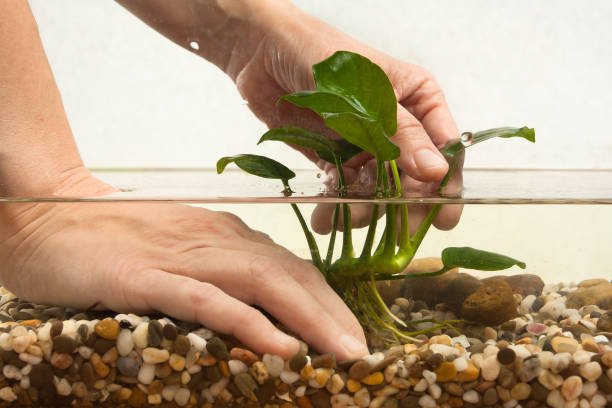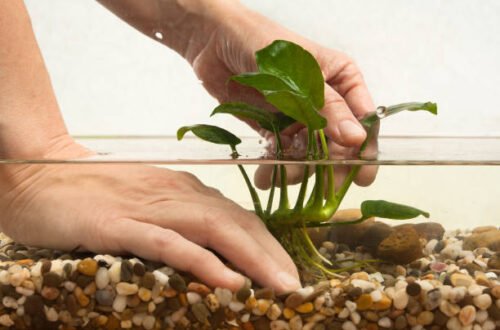Adding live plants to your aquarium can transform it into a beautiful, vibrant underwater landscape. Aquatic plants not only enhance the visual appeal of your tank but also provide numerous benefits, like improving water quality and offering hiding spots for fish. However, keeping aquatic plants healthy requires a bit more than just planting them and hoping for the best. When I first started with live plants, I learned through trial and error how to provide the right conditions for them to thrive. In this guide, I’ll share some basic care tips that will help you maintain healthy, flourishing aquatic plants in your aquarium.
Why Aquatic Plants Are Important for Your Aquarium
Before diving into the care tips, let’s quickly review why aquatic plants are a great addition to any aquarium:
- Improved water quality: Plants absorb nitrates and other harmful compounds from the water, helping to keep it clean and balanced.
- Oxygenation: During photosynthesis, plants release oxygen into the water, which benefits fish and other aquatic life.
- Algae control: Healthy plant growth can outcompete algae for nutrients, reducing algae blooms in the tank.
- Natural habitat: Plants provide hiding spots and shelter for fish, helping to reduce stress and promote natural behaviors.
For more information on the benefits of live plants, check out The Advantages of Live Plants in Aquariums.
Step 1: Choose the Right Plants for Your Tank
The first step to keeping aquatic plants healthy is choosing the right plants for your specific aquarium setup. Not all plants thrive under the same conditions, so it’s important to select species that will work well with your tank size, lighting, and water parameters.
1.1 Low-Light, Beginner-Friendly Plants
If you’re new to keeping live plants, start with hardy, low-maintenance species that can tolerate a wide range of conditions:
- Anubias: Slow-growing, hardy plants that do well in low light and can be attached to rocks or driftwood.
- Java Fern: Another tough plant that can be attached to hard surfaces and does well in low to moderate light.
- Java Moss: Ideal for covering rocks and driftwood, this plant thrives in low light and is great for breeding fish.
- Amazon Sword: Suitable for larger tanks, this plant prefers moderate light and nutrient-rich substrate.
1.2 High-Light, Advanced Plants
For more experienced aquarists with high-light setups and CO2 injection, consider these more demanding plants:
- Carpeting plants: Such as Dwarf Hairgrass or Monte Carlo, which need high light and CO2 for dense, lush growth.
- Red plants: Like Rotala rotundifolia or Ludwigia repens, which need intense light and nutrient supplementation to maintain their vibrant color.
For help in choosing plants, visit Best Aquarium Plants for Beginners and Experts.
Step 2: Provide Adequate Lighting
Lighting is one of the most important factors for plant health. Without the right light, plants can’t photosynthesize properly, leading to slow growth or even death.
2.1 Determine the Lighting Needs of Your Plants
- Low-light plants: Most beginner plants can thrive in low light conditions, typically around 1-2 watts per gallon or using a low-output LED fixture.
- Medium to high-light plants: These require more intense lighting, around 2-4 watts per gallon or high-output LEDs. They also often need CO2 supplementation to thrive.
2.2 Use the Right Type of Light
LED lights are the most popular choice for aquariums because they are energy-efficient, have a long lifespan, and can be tailored to specific spectrums. Look for full-spectrum LED lights with a color temperature of around 6500K-7000K, which closely mimics natural daylight and supports plant growth.
2.3 Set a Consistent Light Schedule
Most aquatic plants need around 8-10 hours of light per day. Too much light can lead to algae problems, while too little can stunt plant growth. Using a timer can help maintain a consistent lighting schedule, which is crucial for plant health.
For more information on choosing the right lighting, check out Complete Guide to Aquarium Lighting for Plant Growth.
Step 3: Use the Right Substrate
Aquatic plants need a suitable substrate to anchor their roots and absorb nutrients. Not all substrates are created equal, so choosing the right one can make a big difference in plant health.
3.1 Nutrient-Rich Substrates
For plants that absorb most of their nutrients through their roots, such as Amazon Swords and Cryptocorynes, a nutrient-rich substrate like Fluval Stratum or Eco-Complete is ideal. These substrates contain essential minerals that promote healthy root development and robust growth.
3.2 Inert Substrates
Inert substrates like plain gravel or sand don’t provide nutrients on their own, so you’ll need to supplement them with root tabs or liquid fertilizers. Plants that are primarily water column feeders, like Java Fern or Anubias, can do well with these substrates as long as they are attached to rocks or driftwood.
3.3 Depth of Substrate
The substrate should be deep enough to support plant roots—typically about 2-3 inches for most species. This depth allows plants to anchor themselves and spread out their root systems effectively.
For more on choosing and setting up substrate, visit Best Substrates for Planted Aquariums.
Step 4: Fertilize Regularly
Just like any other plants, aquatic plants need nutrients to grow. Depending on your tank setup and plant species, you may need to use fertilizers to supplement the nutrients available in the water and substrate.
4.1 Choose the Right Fertilizer
There are two main types of aquarium fertilizers:
- Liquid fertilizers: These are added directly to the water and are ideal for plants that absorb nutrients through their leaves, like stem plants and floating plants.
- Root tabs: These are placed in the substrate and slowly release nutrients over time, making them perfect for root-feeding plants like Amazon Swords and Cryptocorynes.
4.2 Dosage and Frequency
Follow the instructions on the fertilizer packaging for dosing recommendations. Typically, liquid fertilizers are added once or twice a week, while root tabs can be replaced every 1-2 months. Over-fertilizing can lead to algae growth, so it’s important to find the right balance.
For a deeper dive into plant nutrition, check out How to Fertilize Aquarium Plants.
Step 5: Maintain Stable Water Parameters
Keeping the water parameters stable is crucial for the health of both your fish and plants. Plants can be sensitive to sudden changes in water quality, so maintaining consistency is key.
5.1 Monitor pH and Hardness
Most aquarium plants prefer a pH range of 6.5 to 7.5 and moderate water hardness. Some plants, like Amazon Swords and Cryptocorynes, are more tolerant of higher hardness, while others, like certain mosses, prefer softer water.
5.2 Perform Regular Water Changes
Performing regular water changes (about 20-30% weekly) helps remove excess nutrients and waste, keeping the water clean and preventing algae growth. Be sure to use a water conditioner to neutralize chlorine and chloramines in tap water before adding it to the tank.
5.3 Keep an Eye on CO2 Levels
While not all plants require additional CO2, some high-demand plants will benefit from it. If you’re using CO2 injection, aim for a CO2 level of around 20-30 ppm. Even without CO2 injection, maintaining good water circulation and surface agitation can help ensure adequate gas exchange.
For more on water parameters, visit How to Maintain Water Quality in Planted Aquariums.
Step 6: Control Algae Growth
Algae can quickly become a problem in planted tanks, competing with your plants for light and nutrients. Keeping algae under control is essential for the health of your aquatic plants.
6.1 Balance Light and Nutrients
Too much light or excessive nutrients can lead to algae blooms. Make sure your lighting duration doesn’t exceed 10 hours a day and that you’re not over-fertilizing the tank.
6.2 Add Algae-Eating Fish or Invertebrates
Fish like Siamese Algae Eaters, Otocinclus, and invertebrates like Amano shrimp and Nerite snails can help keep algae in check without harming your plants.
6.3 Manual Removal
Use an algae scraper to remove algae from the glass and gently rub algae off plant leaves with your fingers or a soft brush during water changes.
For more on managing algae, check out How to Control Algae in Planted Aquariums.
Step 7: Prune and Trim Regularly
Pruning your plants encourages healthy growth and prevents them from becoming overgrown and shading each other. Regular trimming also helps maintain the aesthetics of your aquascape.
7.1 Trim Dead or Dying Leaves
Remove any yellowing or decaying leaves to prevent them from decomposing in the tank and contributing to poor water quality.
7.2 Shape and Control Growth
For stem plants, trim the tops regularly to promote bushier growth. Replant the cut tops to propagate new plants. For carpet plants, trim them to maintain a low, even coverage.
7.3 Prevent Overcrowding
As plants grow, they can become
crowded and block light from reaching lower leaves or other plants. Thin out dense areas by removing excess plants and replanting them elsewhere or sharing them with fellow aquarists.
For more on pruning, visit How to Trim and Shape Aquarium Plants.
Keeping aquatic plants healthy in your aquarium doesn’t have to be difficult if you follow these basic care tips. By choosing the right plants for your setup, providing adequate lighting and nutrients, and maintaining stable water conditions, you can create a thriving planted tank that enhances the beauty of your aquarium and benefits your fish. Remember, healthy plants are not only a joy to look at but also play a crucial role in the overall balance and health of your aquatic environment.
For more tips and in-depth guides, check out Complete Guide to Aquarium Plant Care.
FAQs
1. Do I need CO2 for my planted tank?
Not all plants require CO2 injection, but it can significantly boost the growth of high-light plants. For low-light, beginner-friendly plants like Anubias and Java Fern, CO2 is not necessary.
2. How often should I fertilize my aquarium plants?
This depends on your plant load and tank conditions. Typically, liquid fertilizers are added once or twice a week, while root tabs should be replaced every 1-2 months.
3. Why are my aquarium plant leaves turning yellow?
Yellowing leaves can be a sign of nutrient deficiency, often a lack of iron or nitrogen. Check your fertilization routine and adjust as needed.
4. Can I use regular gravel for a planted tank?
You can use regular gravel, but it lacks nutrients. Supplement with root tabs or liquid fertilizers to support plant growth, especially for root-feeding plants.
5. What’s the best lighting duration for planted aquariums?
Most aquatic plants do well with about 8-10 hours of light per day. Too much light can lead to algae problems, so using a timer to maintain a consistent schedule is recommended.





